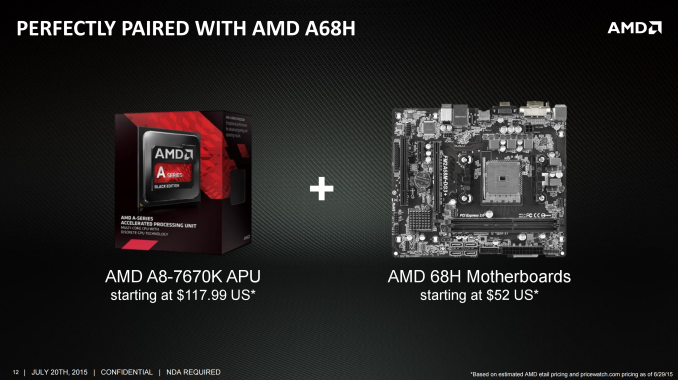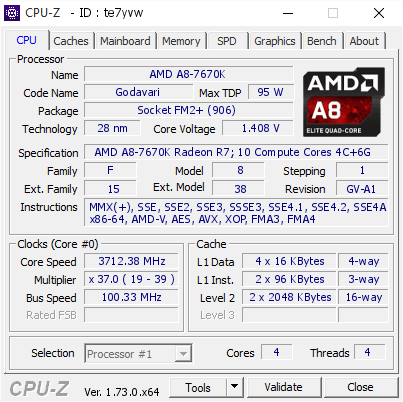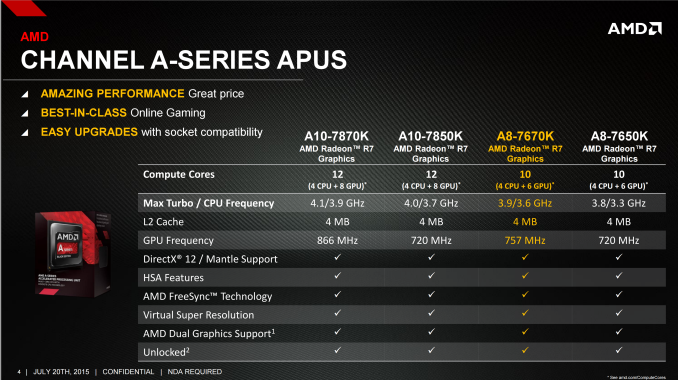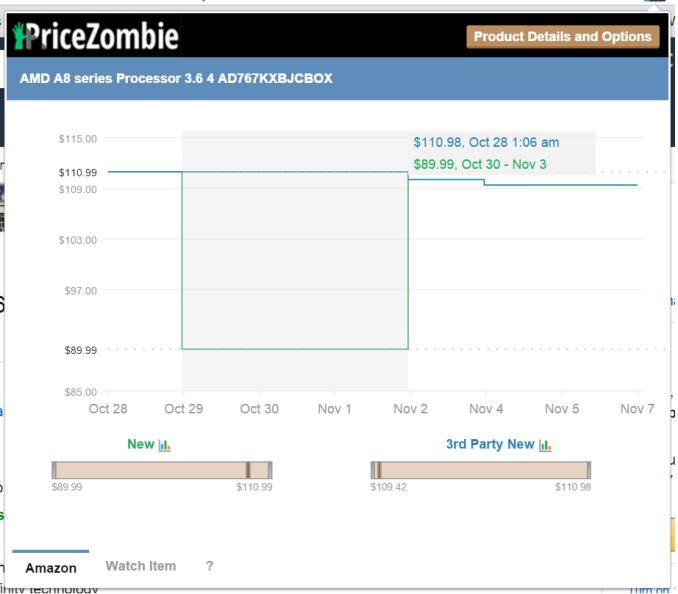The AMD A8-7670K APU Review: Aiming for Rocket League
by Ian Cutress on November 18, 2015 8:00 AM EST
Over the past couple of years, AMD has slowly released their mainstream brand of Kaveri processors. In turn, we have reviewed them, and they consistently aim to provide a midrange integrated gaming option, especially for those on a budget. The recent release of the A8-7670K was perhaps not that exciting, as AMD is filling up their product stack with new parts, taking advantage of an improved manufacturing process and aggressive binning. To that end, we're taking a different tack with this review. Alongside the regular tests, we also corralled Rocket League (an amazingly simple yet popular take on car football/soccer that sits on the precipice of e-sports glory) into a benchmark aimed at those sub-$600 gaming systems.
The AMD A8-7670K
Earlier this year, AMD announced their new line of Kaveri Refresh processors, starting with the A10-7870K (which we reviewed here). As the name suggests, these are Kaveri processors at their core, still based on the combination of Steamroller processor cores and 2nd generation Graphics Core Next (GCN) microarchitecture for graphics. These new refresh models are designed to take advantage of minor improvements in manufacturing, resulting in the ability to get higher clock speed for the same power consumption, even 18 months after the first Kaveri processors hit the scene. As a result, these Refresh processors — or, to use AMD's internal code name, "Godavari" — fill in the blank spots in the product stack and supersede the older parts, with the aim of squeezing in more frequency and performance for the same power consumption. It sounds deceptively simple — improve your process, refresh the part at the same price, and reap the benefits.
If we look at AMD's current lineup, we see that this new A8-7670K surpasses the older A10-7700K on the specification sheet, and comes in cheaper when brand-new.
| AMD Kaveri Lineup | ||||||||
| A10- 7870K |
A10- 7850K |
A10- 7800 |
A10- 7700K |
A8- 7670K |
A8- 7650K |
A8- 7600 |
X4 860K |
|
| Price | $137 | $134 | $131 | $120 | $118 | $104 | $89 | $85 |
| Modules | 2 | 2 | 2 | 2 | 2 | 2 | 2 | 2 |
| Threads | 4 | 4 | 4 | 4 | 4 | 4 | 4 | 4 |
| Core Freq. (GHz) | 3.9-4.1 | 3.7-4.0 | 3.5-3.9 | 3.4-3.8 | 3.6-3.9 | 3.3-3.8 | 3.1-3.8 | 3.7-4.0 |
| Compute Units | 4+8 | 4+8 | 4+8 | 4+6 | 4+6 | 4+6 | 4+6 | 4+0 |
| Streaming Processors |
512 | 512 | 512 | 384 | 384 | 384 | 384 | N/A |
| IGP Freq. (MHz) | 866 | 720 | 720 | 720 | 754 | 720 | 720 | N/A |
| TDP | 95W | 95W | 65W | 95W | 95W | 95W | 65W | 95W |
| DRAM Frequency |
2133 | 2133 | 2133 | 2133 | 2133 | 2133 | 2133 | 1866 |
| L2 Cache | 2x2MB | 2x2MB | 2x2MB | 2x2MB | 2x2MB | 2x2MB | 2x2MB | 2x2MB |
As it stands, the A8-7670K is a dual-module 3.6 GHz base frequency processor with a boost frequency up to 3.9 GHz. It comes with six graphics compute units, which translates to 384 streaming processors, similar to other A8 parts, but at a slightly higher IGP frequency of 754 MHz. The combined increase in processor and integrated graphics frequencies come at no extra cost in thermal design, with the A8-7670K at the same 95W TDP.
One of AMD's marketing strategies with these ~$100 processors is the price/performance angle. Aside from the integrated graphics, each of the AMD processors can pair with an R7 240 or R7 250 graphics card (DDR3 or GDDR5; AMD suggests an R7 250 GDDR5, as you might expect) in a hybrid dual graphics scenario, boosting performance. Thus, for the same price as an APU and an R7 250 graphics card, on average, AMD aims to offer a better gaming experience — especially for games that run at around 60 frames per second on medium settings — than a similarly priced Intel + NVIDIA platform. We've seen this marketing spiel corroborated in previous reviews, and would expect not to see anything different here. At launch, AMD put a $118 price on the A8-7670K, which, in recent sales, has been pushed down to under $100 at times.
The A8-7670K is an FM2+ socket processor, and thus requires either an A88X, A85X, A78 or A68 motherboard to go with it in order to take full advantage. As part of the launch, and given that this processor is a slightly boosted A8-7650K, AMD sees value in pairing it with something like a $50 A68H motherboard, making an APU+MB combination around $150 when on sale. However, as one might imagine, due to the age of the FM2/FM2+ socket, there are relatively few "new" motherboards on the market. The last one we reviewed was MSI's A88X-G45 Gaming, which brought over some of the components seen on its new Intel gaming motherboards, but other manufacturers have also put out M.2 capable AMD chipset-based motherboards as well.













154 Comments
View All Comments
BurntMyBacon - Thursday, November 19, 2015 - link
@Ian Cutress: "It's never an issue of lack of interest or subversion, just procurement (and ensuring we can communicate with the manufacturer at the point of testing)."[sarcasm]I thought Intel and all other computer hardware manufacturers were required by LAW to send their products to Anandtech for prelaunch approval where Supreme Tech Justice Cutress and his colleagues pronounce life or death on potential products. ;' ) [/sarcasm]
Seriously though, I'd say you are doing fine despite the real world procurement and scheduling issues getting in the way.
flabber - Wednesday, November 18, 2015 - link
I can't agree any more with the point that power consumption is the least of my concerns. While there is a significant difference between a 250W TDP CPU and a 50W TDP CPU, where one would have to factor in the cost of cooling and a PSU, 100W is quite manageable. A 500W PSU is more that adequate for just about any current system. However, I am aware that decreased power consumption is an objective in all consumer products and will be seeing in upcoming computer components. (Ironically for mobile components, my 2009 Blackberry with a 1150mAh battery can still run for a couple days before I need charge it.)My rig is equipped with a A10-5800k (2012) and a year old R9-290X (2013). Everyday tasks, such as using a spreadsheet, word processor, citation management or occasional image editing, can't be improved in any noticeably way. With regard to gaming, I can't be bothered to upgrade the motherboard and CPU to a superior Intel alternative. A few more frames per second won't make a game with poor storyline any better, nor will an enjoyable game become any better.
Pissedoffyouth - Thursday, November 19, 2015 - link
If you have 5800 you should look at getting a kaveri for better performance and lower power consumptionGadgety - Thursday, November 19, 2015 - link
"AMD's first talking point is, of course, price. AMD considers their processors very price-competitive"No kidding, I got the A8-7600 for my kid and it's integrated graphics is comparable to the i7 Iris Pro, where the i7 is 5x more expensive. So for 20% of the price we get to enjoy graphics galore. Put it on Asrock's A88X M-ITX motherboard and it outputs 4K cinema. No graphics card means it's compact so we use a tiny chassis, perfect HTPC, and useable for the type of light gaming the kids do.
Gadgety - Thursday, November 19, 2015 - link
@Ian Cutress The performance parity, and sometimes superiority, of the A8-7670k compared to the A10-7850k, and also to the A10-7870k, I guess could be attributable to driver improvements. Did you use the same drivers, or updated versions? If it's improved drivers, this would likely also improve across the APU-range.Ian Cutress - Thursday, November 19, 2015 - link
Same drivers for each. I lock a set of drivers down every test-bed refresh, so in this case it would be 15.4 beta, which is getting a bit old now. Kaveri Refresh does have some minor internal improvements as well I imagine, internal bus frequencies perhaps. There's always a small amount of volatility in the benchmark, depending on what heat density or board issue you might have. Looking back, we haven't always used the same motherboard on the APUs just due to timing (but all A88X), and even though we do some overriding on power profiles it can be difficult to compensate for motherboard manufacturer non-user exposed firmware optimisations on the memory buses.Come the next year test-bed refresh (with DX12 relevant titles hopefully), I'll be going back and redoing them all. That should clear out the cobwebs on the latest drivers and updates, providing a new base.
milli - Thursday, November 19, 2015 - link
Ian Cutress, how is the review of your grandparents laptop coming along? :)I'm waiting for that Carrizo review.
zlandar - Thursday, November 19, 2015 - link
I don't see the point of being so cheap that you are unwilling to spend more for a superior i3-5 and discrete video card. Why would you chain yourself to a dead-end cpu/gpu integrated combo and motherboard that isn't very good to start with?Plenty of people have pointed out how well Intel's cpu have held up since Sandy Bridge. I'm still using a 2600k and have upgraded my video card 3 times. If you are on a tight gaming budget it makes alot more sense to buy 2nd-3rd tier last gen video cards coupled with a good cpu you don't need to upgrade.
BurntMyBacon - Thursday, November 19, 2015 - link
@zlandar "Why would you chain yourself to a dead-end cpu/gpu integrated combo and motherboard that isn't very good to start with?"Aren't just about all laptops deadend with respect to CPU/GPU? (Particularly in the Carrizo price range)
Ton's of laptops are sold without discrete GPUs and no option to upgrade. Why should this matter to a Carrizo review (clearly laptop in this request)?
Ian Cutress - Thursday, November 19, 2015 - link
Something special in the works. After SC15 finishes, I'll be digesting the mountain of data I have. :)